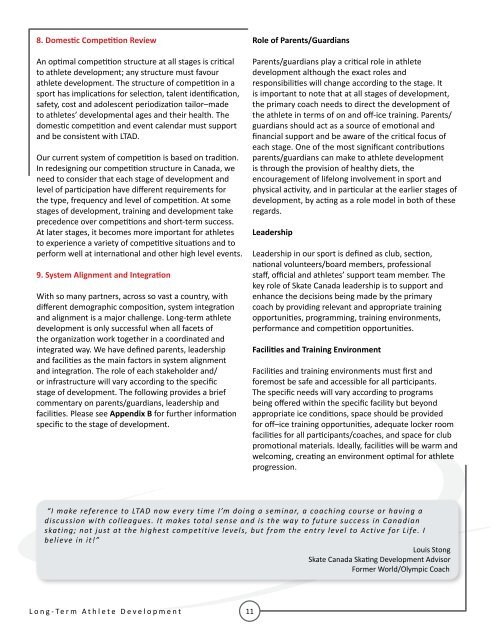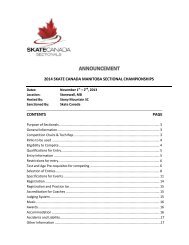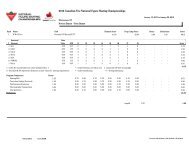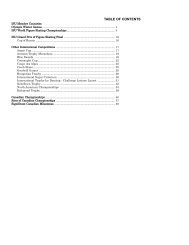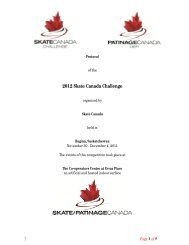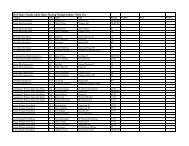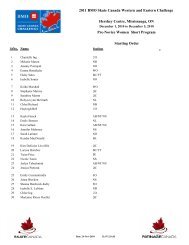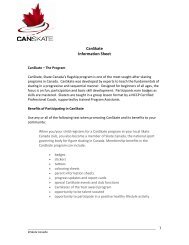LONG-TERM ATHLETE DEVELOPMENT - Skate Canada
LONG-TERM ATHLETE DEVELOPMENT - Skate Canada
LONG-TERM ATHLETE DEVELOPMENT - Skate Canada
Create successful ePaper yourself
Turn your PDF publications into a flip-book with our unique Google optimized e-Paper software.
8. Domestic Competition Review<br />
An optimal competition structure at all stages is critical<br />
to athlete development; any structure must favour<br />
athlete development. The structure of competition in a<br />
sport has implications for selection, talent identification,<br />
safety, cost and adolescent periodization tailor–made<br />
to athletes’ developmental ages and their health. The<br />
domestic competition and event calendar must support<br />
and be consistent with LTAD.<br />
Our current system of competition is based on tradition.<br />
In redesigning our competition structure in <strong>Canada</strong>, we<br />
need to consider that each stage of development and<br />
level of participation have different requirements for<br />
the type, frequency and level of competition. At some<br />
stages of development, training and development take<br />
precedence over competitions and short-term success.<br />
At later stages, it becomes more important for athletes<br />
to experience a variety of competitive situations and to<br />
perform well at international and other high level events.<br />
9. System Alignment and Integration<br />
With so many partners, across so vast a country, with<br />
different demographic composition, system integration<br />
and alignment is a major challenge. Long-term athlete<br />
development is only successful when all facets of<br />
the organization work together in a coordinated and<br />
integrated way. We have defined parents, leadership<br />
and facilities as the main factors in system alignment<br />
and integration. The role of each stakeholder and/<br />
or infrastructure will vary according to the specific<br />
stage of development. The following provides a brief<br />
commentary on parents/guardians, leadership and<br />
facilities. Please see Appendix B for further information<br />
specific to the stage of development.<br />
L o n g - Te r m A t h l e t e D e v e l o p m e n t<br />
865 Sheord Road, Ottawa, Ontario K1J 1H9<br />
Phone 613.747.1007 I Toll Free 1.888.747.2372 I Fax 613.748.5718 I Toll Free Fax 1.877.211.2372<br />
11<br />
Role of Parents/Guardians<br />
Parents/guardians play a critical role in athlete<br />
development although the exact roles and<br />
responsibilities will change according to the stage. It<br />
is important to note that at all stages of development,<br />
the primary coach needs to direct the development of<br />
the athlete in terms of on and off-ice training. Parents/<br />
guardians should act as a source of emotional and<br />
financial support and be aware of the critical focus of<br />
each stage. One of the most significant contributions<br />
parents/guardians can make to athlete development<br />
is through the provision of healthy diets, the<br />
encouragement of lifelong involvement in sport and<br />
physical activity, and in particular at the earlier stages of<br />
development, by acting as a role model in both of these<br />
regards.<br />
Leadership<br />
Leadership in our sport is defined as club, section,<br />
national volunteers/board members, professional<br />
staff, official and athletes’ support team member. The<br />
key role of <strong>Skate</strong> <strong>Canada</strong> leadership is to support and<br />
enhance the decisions being made by the primary<br />
coach by providing relevant and appropriate training<br />
opportunities, programming, training environments,<br />
performance and competition opportunities.<br />
Facilities and Training Environment<br />
Facilities and training environments must first and<br />
foremost be safe and accessible for all participants.<br />
The specific needs will vary according to programs<br />
being offered within the specific facility but beyond<br />
appropriate ice conditions, space should be provided<br />
for off–ice training opportunities, adequate locker room<br />
facilities for all participants/coaches, and space for club<br />
promotional materials. Ideally, facilities will be warm and<br />
welcoming, creating an environment optimal for athlete<br />
progression.<br />
“I make reference to LTAD now every time I’m doing a seminar, a coaching course or having a<br />
discussion with colleagues. It makes total sense and is the way to future success in Canadian<br />
skating; not just at the highest competitive levels, but from the entry level to Active for Life. I<br />
believe in it!”<br />
Louis Stong<br />
<strong>Skate</strong> <strong>Canada</strong> Skating Development Advisor<br />
Former World/Olympic Coach


